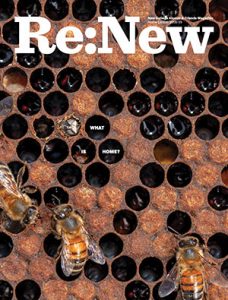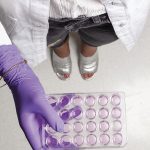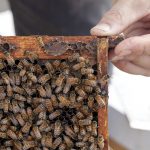A conversation with Métis advocate and teacher Doug Anderson about Indigenous placemaking, cultural resurgence and hope.
The students give Doug Anderson hope. Every Monday afternoon since the beginning of the semester, he and they have met in class to talk and swing things around. Because that, ideally, is what Anderson designed NEW348 (Special Topics in Equity Studies: Indigenous Relationships with Place in Urban Centres) to do: to take accepted notions and assumptions and turn them inside out and on their head.
The idea of an inverted perspective, of a radical transformation, is an urgent matter to Anderson—and has been for decades. The co-founder of both Invert Media and NKG (Naadmaagit Ki Group, Anishinaabe for “Helpers of the Earth”), whose family is Bungi (Bungee) Métis from Manitoba, is currently pursuing his doctoral studies in education at York University, but Anderson has taken on the roles of educator and advocate for most of his life. Or, as he prefers to say, he intervenes as “a kind of helper or civil servant” to facilitate and ensure respectful, ethical and appropriate processes and representation in interactions between Indigenous communities and various kinds of bureaucracies and institutions in Canada.
This can mean many things. Invert Media provides and disseminates, in a variety of print and digital formats, ideas rooted in Indigenous knowledge. It always happens in close collaboration with First Nations, Métis and Inuit communities, prioritizing the cultural protocols that exist in each group. The grassroots organization NKG uses agricultural initiatives to restore connections that Indigenous people have to natural land in the city. And as an educator in schools and universities, Anderson shares with people from diverse cultural backgrounds Indigenous perspectives on land and place and how these can—and must, in fact—inform current debates on almost any topic in this country.
Anderson has worked in and alongside the halls of institutional power in government and education long enough to recognize real signs of change. In recent years, he has seen many people in leadership roles show a genuine openness and commitment to transformation, attitudes that have replaced the more widespread bigotry and dismissal of the past. But—we may be running out of time. “There’s an ecological, economic and social sort of paralysis and breakdown, and it’s escalating,” he says. These developments—long in the making—have now created a general sense of urgency, but also, among Indigenous communities, a cultural resurgence. Either way, Anderson claims, people understand that we, meaning everyone, need to get moving: “We are going to have to light the metaphorical fire.”
Which brings us back to New College and the undergraduates in NEW348. They, and young people like them, Anderson believes, whether they are Indigenous or not, hold the key to the future: because their minds are more open, their energy more bountiful and their outside responsibilities less weighty. Giving youth the tools to fully understand Indigenous perspectives, which in their groundedness and particular spiritual orientation differ quite markedly from many non-Indigenous ones, might actually bring about reshaped attitudes and behaviours. It offers a better alternative to the culture of brief consultation (as well intended as the latter may be), which often narrows and compresses Indigenous conceptualizations to the point of disappearance. Besides, even in a generally non-religious framework such as Canada, “the one thing that’s left that I think everyone can agree is sacred is their children,” Anderson states. Their insights and well-being thus hold a particular power even for an older generation.
So what happens in the course? During the 12 weeks of class, the students are obviously exposed to certain reading materials and a number of lectures. More important, however, will be the experiential component of their learning: immersing themselves in the land outside, entering into conversations with guests, building deeper connections with each other through shared activities. Challenging questions will weave their way through most days: What makes an ally? What do the covenants and treaties really mean? Might the covenants, rather than legislation, be used as tools that enable everyone on the territories to share the land in a balanced and healthy way? How do symbols structure perceptions and how can completely tearing a symbol apart and reconstructing it lead to changed outcomes? To Anderson, the course quite simply constitutes “an opportunity to really move a group of people into a deeper awareness, also of the implications of all these ideas.”
It’s a mouthful, he admits, but an essential task, also in relationship to the complex and potentially contentious concept of home. A better sense of home for everyone, Anderson believes, emerges from less disruption, less disjointedness, less unsettledness between elements. And he hopes the next generation, the one he’s helping educate now, might come closer to this ideal: “We’re asking that all the people who have been here, all those who are going to be here and all the layers of the universe that we really can’t perceive are respected. And then we’re home.”


![Portrait of a seated, smiling woman with box braids and folded hands [Lydia Gill in U of T’s Convocation Hall]; rows of seats visible behind her.](http://renew.newcollege.utoronto.ca/wp-content/uploads/2019/04/Lydia-Gill-900px-150x150.jpg)


![Portrait of a woman with long, dark hair and glasses, smiling at the camera [Anne McGuire].](http://renew.newcollege.utoronto.ca/wp-content/uploads/2019/04/AnneMcGuire-900px-landscape-150x150.jpg)

